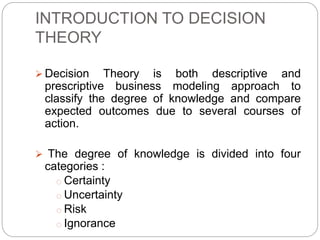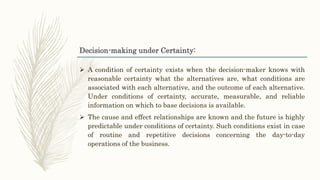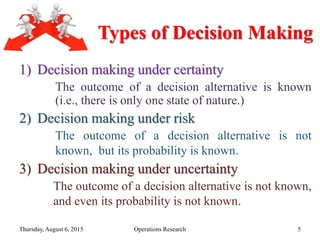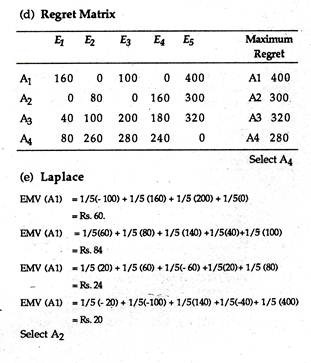Decision making is a crucial aspect of our lives, as it helps us to choose the most appropriate course of action in a given situation. There are three main types of decision making: under certainty, under uncertainty, and under risk. Each of these types of decision making involves different approaches and considerations, and it is important to understand the differences between them in order to make informed and effective decisions.
Decision making under certainty refers to situations where all of the relevant information is known and the outcome of a decision is certain. For example, if you know that it will rain tomorrow and you have an umbrella, the decision to bring the umbrella with you when you go outside is certain. In this type of decision making, the focus is on determining the optimal course of action based on the available information.
Decision making under uncertainty refers to situations where some of the relevant information is unknown or the outcome of a decision is uncertain. For example, if you are trying to decide whether or not to invest in a new business venture, you may not know for certain whether the venture will be successful or not. In this type of decision making, the focus is on determining the probabilities of different outcomes and making a decision based on the expected value of the potential outcomes.
Decision making under risk refers to situations where the outcome of a decision is uncertain and there is a potential for a negative outcome. For example, if you are considering taking a new job, you may be uncertain about whether or not the job will be a good fit for you, and there is a risk that you may not enjoy the work or that the job may not be as financially rewarding as you had hoped. In this type of decision making, the focus is on minimizing the potential negative outcomes and maximizing the potential positive outcomes.
In all types of decision making, it is important to gather as much information as possible in order to make an informed decision. This may involve researching the options, consulting with others, or considering the potential consequences of different actions. It is also important to consider your own values and goals when making a decision, as these can help to guide your decision making process.
Overall, decision making under certainty, uncertainty, and risk all involve different approaches and considerations, but the ultimate goal is the same: to choose the most appropriate course of action in a given situation. By understanding the differences between these types of decision making and gathering relevant information, we can make informed and effective decisions that help us to achieve our goals and lead fulfilling lives.








